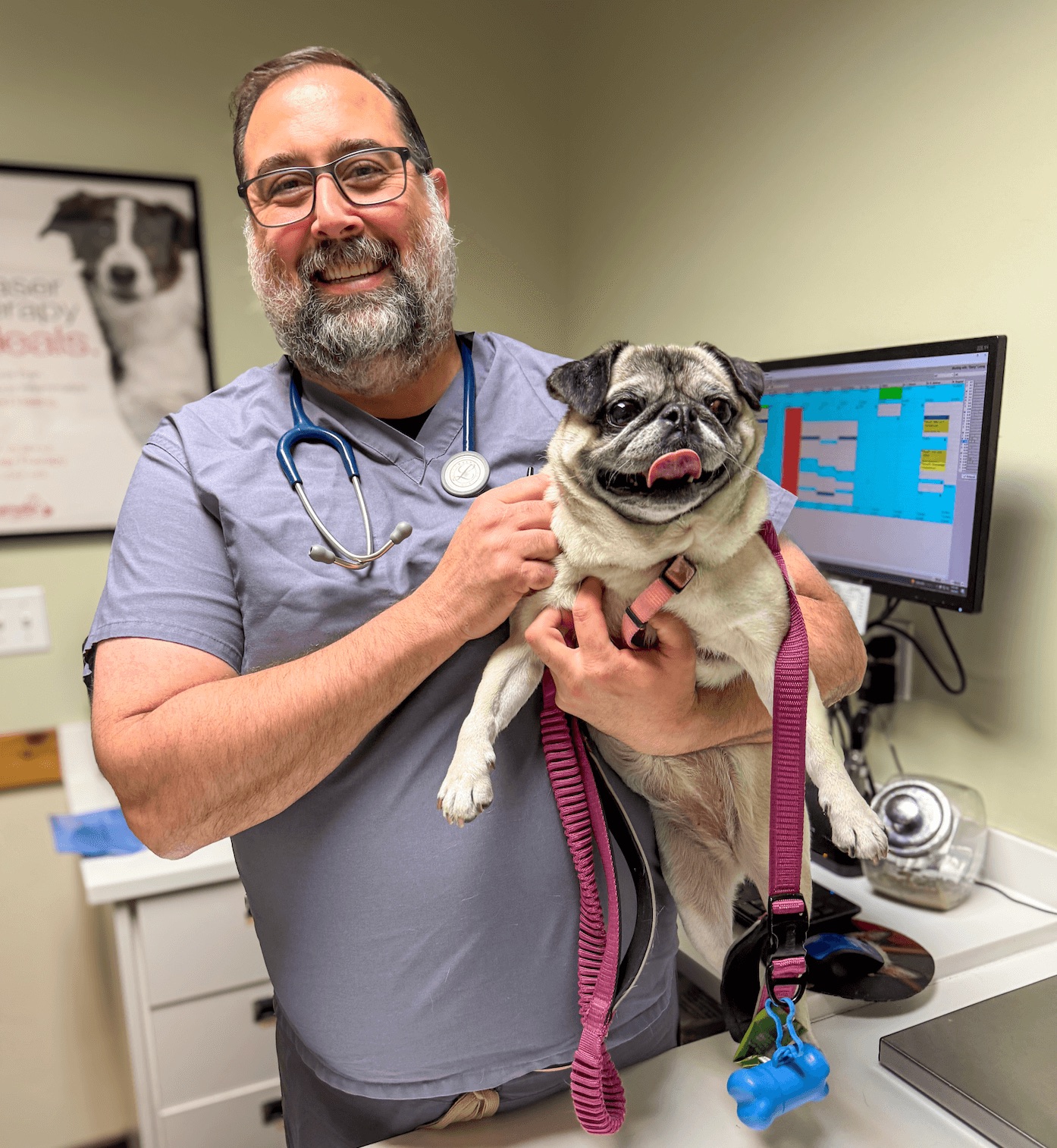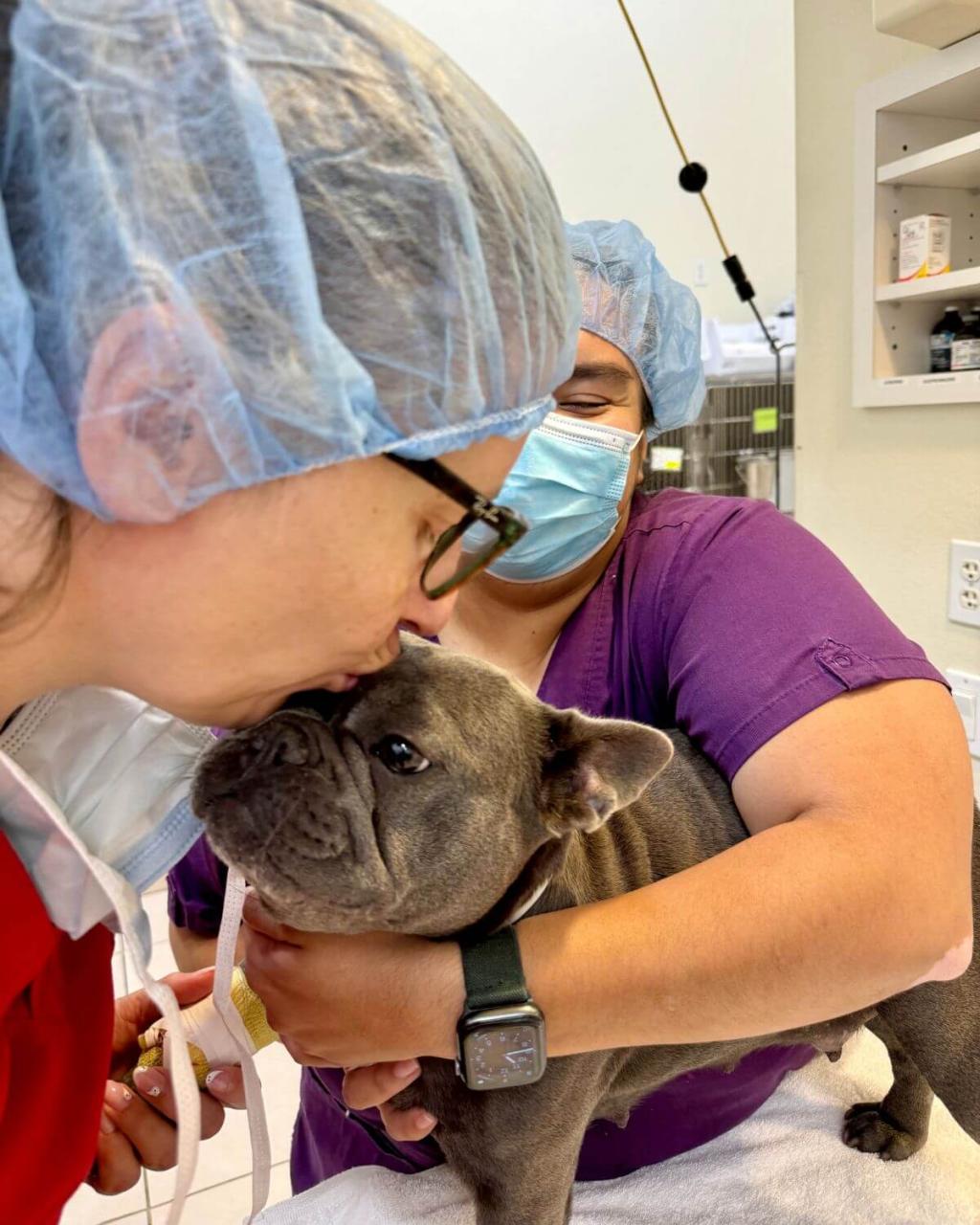How to Care for Brachycephalic Dogs and Manage Breathing Issues
What are brachycephalic dog breeds, and what makes them unique?
What an excellent question. This is a prime example of a brachycephalic breed, the French bulldog, the number one most popular brachycephalic breed in North America at the moment. Brachycephalic breeds are atypical for most dogs in that they have a shortened face. From the back of her skull to the tip of her nose, it's a much shorter distance. In shortening that distance, we have the same amount of teeth organized in a shorter space, leading to prominent facial folds, and the respiratory tract is reduced in length and kind of squished together.
Now, if I compare her to a typical breed like your English Labrador, you can see that their face from the back of the skull to the tip of the nose is a lot longer. We also see that their nostrils tend to be much more open, they don't have the same reduced space and crowding of all of their teeth, and the airflow from their nose to their lower airways is smoother as well. Using our French bulldog as an example of a brachycephalic breed, what also makes them unusual and unique about their airways is that they have narrowed openings to the nasal cavity and reduced space for air flowing over the nasal turbinates as air comes in through their upper airways, passes by the soft palate, and then heads down towards their trachea.
Some other unusual features of the brachycephalic dog include a thickened tongue and a thickened soft palate, reducing or restricting airflow in their upper airways. They may have at the point of the opening of their trachea something called eversion of the laryngeal saccules, which are two little flabby tissue pieces that can come out from either side and again occlude that upper airway.
Lastly, some of our brachycephalic breeds may have a narrow trachea, often called a hypoplastic trachea. These are the basic conditions that lead to abnormal and restricted airflow in the brachycephalic breed.
What is brachycephalic obstructive airway syndrome?
Another excellent question. It can also be called BOAS for short. Brachycephalic refers to the shape of their face being shortened from front to back. Obstructive means that airflow isn't moving in a nice laminar fashion. It's actually going over twists and bends and creating a turbulent type of airflow. In practical terms, this usually means we hear things like a roaring or a snoring sound as air moves over those restricted airways.
What are the common health issues in brachycephalic dog breeds?
 Common issues, apart from just the bits of snoring and the abnormal airflow, include crowding and rotation of teeth leading to periodontal disease, tooth loss, and bad breath. These dogs can also get overheated quickly. Most cooling in the dog happens through the respiratory tract via panting, so dogs with airflow restrictions can get overheated and give themselves heat stroke really quickly. It doesn't take much, just a quick walk on a hot day or overexertion at play can result in heat stroke.
Common issues, apart from just the bits of snoring and the abnormal airflow, include crowding and rotation of teeth leading to periodontal disease, tooth loss, and bad breath. These dogs can also get overheated quickly. Most cooling in the dog happens through the respiratory tract via panting, so dogs with airflow restrictions can get overheated and give themselves heat stroke really quickly. It doesn't take much, just a quick walk on a hot day or overexertion at play can result in heat stroke.
The obstructed upper airway can cause problems with the digestive system, such as esophageal reflux or GERD. We can see hiatal hernias in the dog. Because they're mostly breathing through their mouth and less through their nostrils, we can see lots of swallowing air leading to flatulence.
Since I specialize in reproductive medicine, something near and dear to my heart is the effect of these restricted upper airways on the reproductive system. In male dogs, I may see urethral prolapse, leading to blood in urine and difficulty urinating. In female dogs, we can see difficulty at birth due to the large size of these dogs' skulls relative to the small size of the female pelvis.
But there's more to it: late in pregnancy, with a large litter, they have a slack abdomen. The puppy's head size is large relative to other breeds going through the maternal pelvis. If you're a mom with a big abdomen and you have to deliver more than five puppies, how well do you think you're going to push in labor and delivery? Probably not well. For breeds like English bulldogs, French bulldogs, and Boston terriers, it's recommended to have an elective C-section to avoid a painful and difficult labor and the risk of losing puppies.
How can I tell if my brachycephalic dog is experiencing breathing difficulty?
A lot of the time, we can hear the difficulty in breathing through increased noise. Signs of a dog struggling to breathe, especially a brachycephalic, include bright pink or bluish mucous membranes. Sometimes you'll see a lot of saliva or froth on their face because they're struggling to swallow and breathe at the same time. You may also notice the dog looking tired and exhausted, choosing to lay down a lot.
What are the best ways to manage breathing issues in brachycephalic dogs?
Knowledge is power here. Be aware of how severe the dog's brachycephalic condition is. The University of Cambridge developed a grading scale, now adopted by the Orthopedic Foundation for Animals, to rate these dogs from zero to four, describing how severely affected a dog is with their brachycephalic syndrome and how much of an obstruction to their upper airways is created.
You can have your dog's respiratory function evaluated by your general veterinarian. We recommend that breeders obtain the respiratory function grading system certification of their dogs prior to use in a breeding program. This allows for evaluation of severity and removal of the most severely affected dogs from the breeding pool, as well as making valuable decisions about breeding pairs to select offspring that are less affected over time.
Learn More About Respiratory Function Grading or BOAS
Is anesthesia safe for brachycephalic dogs?

In general, anesthesia can be made safe, but these dogs have the complication of restricted airways. This means that both prior to induction of anesthesia and during recovery, we must ensure successful airflow. These dogs may receive preoxygenation and require close monitoring before and after anesthesia to keep their airways as open as possible.
As an example, a more mesocephalic or normal airway dog shows a large pathway for airflow with the endotracheal tube in place. Even mildly sedated and removing the endotracheal tube, we still monitor that dog to ensure its upper airways don't become obstructed.
In comparison, a severely brachycephalic animal may only accommodate a tiny endotracheal tube. This dog requires close monitoring and management post-anesthesia to ensure open airways at all times to avoid respiratory arrest.
What surgical options are available for severe breathing problems?
In mild cases, your general practitioner may discuss correction of the upper airways, such as opening the nasal passages to change from a slit-like to a more open appearance. Soft palate correction is often performed by many veterinarians.
In severe cases, like eversion of the laryngeal saccules or hypoplastic trachea, a veterinary specialist in surgery may be required. These surgeries can come with complications, so it's ideal to select the least affected dogs initially for better success over their lifetime.
What should I know about choosing a puppy from a brachycephalic breed?
They are adorable, aren't they? However, don't just pick the most energetic and cutest one. Evaluate their nasal passages. A puppy with good upper airways may have narrow nostrils, but not slit-like as in severe cases. Listen for heavy breathing or roaring sounds at rest or play. Also, consult with breeders about their stock.
The University of Cambridge developed a system for rating dogs, currently available for English, French bulldogs, and Chinese pugs. The respiratory function grading scheme evaluates classes from zero to three. We should select out all grade threes from a breeding program. A grade two dog with high genetic value might tentatively be used with a grade zero or one partner. Eventually, replace the grade two dog with lesser affected offspring to make the best breeding decisions.
What are the risks of traveling with a brachycephalic puppy?
With a puppy this cute, you probably want to travel everywhere with it. But dogs that are highly stressed are prone to heat stroke due to restricted airways. Traveling, especially by air, can be a concern. At altitude, oxygen is less available, and these dogs labor more at breathing. Some airlines refuse to carry these breeds due to safety concerns.
How can I improve the overall quality of life for my brachycephalic dog?
Consult your veterinarian to stage the severity of brachycephalic obstructive airway syndrome. It's important to know what you're dealing with to plan for the future. Simple measures like maintaining a stress-free environment, limiting activity to what the dog can tolerate, and observing for signs of breathing distress are crucial. Avoid heavy activity on hot days and possibly refrain from air travel for severely affected dogs to manage their well-being.
If you're a pet owner with questions about your brachycephalic dog and brachycephalic obstructive airway syndrome, or a breeder seeking help with breeding practices and pair selection, please call us at (949) 612-2756 or email [email protected]. We’re here to keep your pet healthy, happy, and thriving!

